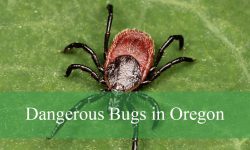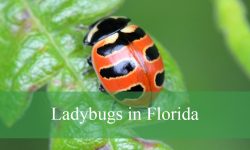Across the warm plains, forests, and coastal regions of Texas, flashes of emerald green often catch the eye — signs of the state’s beautiful green lizards. These reptiles range from tiny, quick-moving anoles to large, commanding species like the Knight Anole, each thriving in its own corner of the Texas landscape.
Texas’s climate, with its long summers and mild winters, provides an ideal home for both native and introduced green lizards. Some, like the Green Anole, are familiar backyard residents, while others — such as the Knight Anole and the Italian Wall Lizard — arrived from tropical regions and have adapted perfectly to the state’s warm, diverse environments.
From dedicated reptile enthusiasts to curious gardeners, anyone can appreciate the charm of these colorful creatures. This guide introduces eight types of green lizards found in Texas, detailing their appearance, size, habitat, and behavior while celebrating the diversity of Texas’s reptile world.
Types of Green Lizards Found in Texas
Green Anole (Anolis carolinensis)
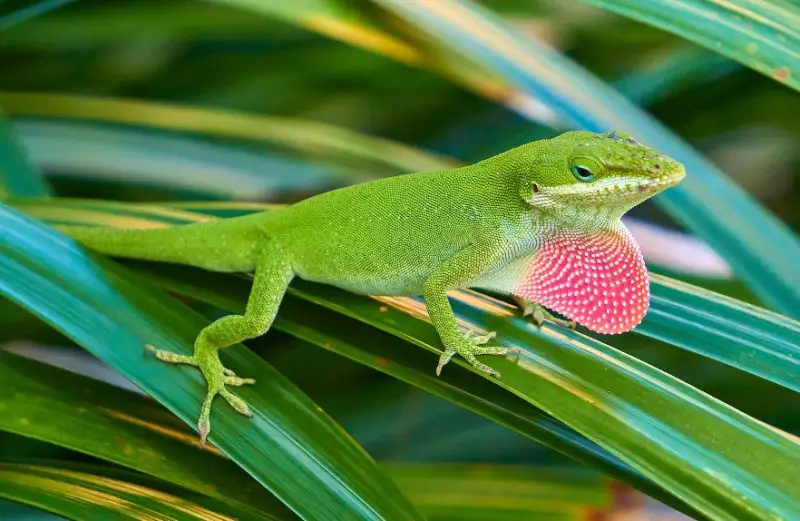
The Green Anole is one of the most recognizable reptiles in Texas, often referred to as the “American chameleon” due to its ability to shift between vivid green and brown shades. Its slender body, long tail, and pointed snout give it a graceful appearance, while its smooth, glossy scales enhance its bright emerald color. Adult males are typically between 5 and 8 inches in total length, with a slightly larger head and a pink dewlap used for display, while females are smaller and more uniform in tone.
Color change in Green Anoles serves multiple purposes — temperature regulation, camouflage, and communication. When relaxed and in good health, they appear bright green, but stress, cool temperatures, or territorial interactions can make them turn brown. This adaptive coloration helps them blend into leaves or bark depending on their surroundings. Their large, expressive eyes and agile movements make them captivating to watch in gardens and wooded areas.
Behaviorally, Green Anoles are diurnal and arboreal, preferring to live in shrubs, fences, and tree branches. Males are highly territorial, engaging in push-ups and head-bobbing to warn rivals and attract mates. During courtship, males display their pink throat fan and circle around females before mating. These anoles primarily feed on small insects such as flies, moths, and spiders, which they capture with quick tongue flicks.
In Texas, Green Anoles are most abundant in the eastern and southern parts of the state, where humidity and vegetation are plentiful. They thrive in suburban gardens, forest edges, and even on porches. Females lay single eggs every few weeks throughout the warm months, hiding them in moist soil or under leaf litter. This species’ adaptability to both urban and natural environments makes it one of Texas’s most common and charming green lizards.
Knight Anole (Anolis equestris)
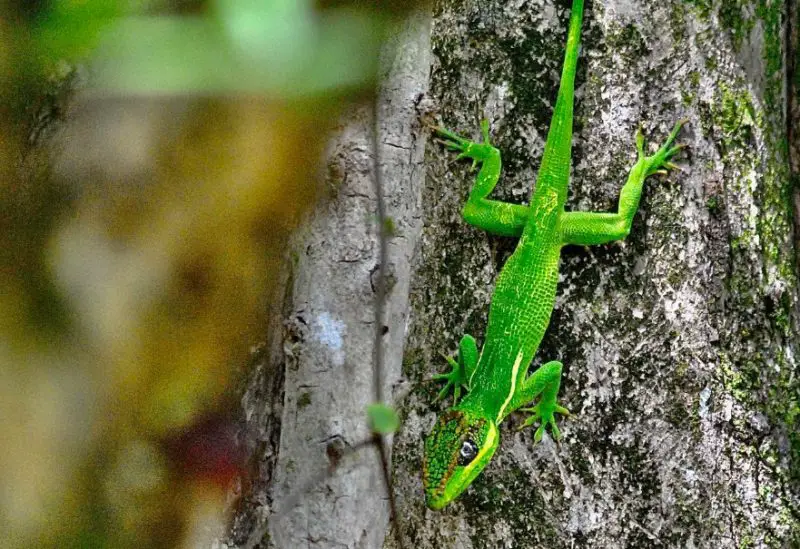
The Knight Anole is a large and vividly green species originally native to Cuba but occasionally found in southern Texas, particularly in areas with warm, humid climates similar to South Florida. It is the largest species of anole in North America, reaching up to 13 inches long, with a muscular body, long tail, and large triangular head. Its brilliant lime-green coloration, yellow jaw stripe, and pink dewlap make it unmistakable.
In Texas, Knight Anoles are rare and usually restricted to isolated urban populations or greenhouses where they have been accidentally introduced. They prefer arboreal habitats — trees, palms, and tall shrubs — and are diurnal, spending much of the day basking or hunting among branches. Their sharp claws and strong limbs make them agile climbers.
These lizards are primarily insectivorous but may also consume small vertebrates, including frogs and other lizards. They use ambush tactics, remaining motionless before lunging swiftly at their prey. Males are territorial and display aggressive behaviors such as head-bobbing, dewlap extension, and open-mouth threats to intimidate rivals.
Breeding occurs in warm months, and females lay a few eggs in soil or leaf litter. Though not native to Texas, the Knight Anole’s vivid color and bold demeanor make it one of the most striking green lizards occasionally seen in the state. Its presence serves as a reminder of how tropical reptiles can adapt to human-altered landscapes when conditions are favorable.
Italian Wall Lizard (Podarcis siculus)
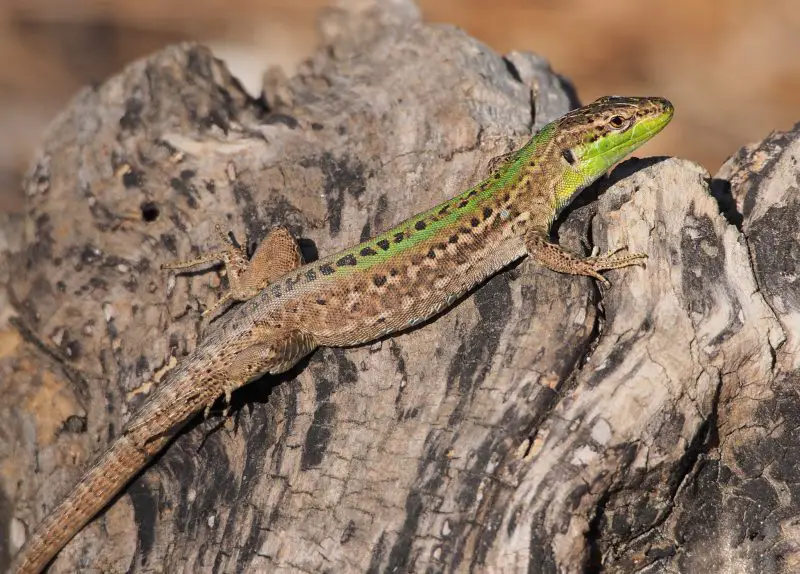
The Italian Wall Lizard (Podarcis siculus) is a bright, energetic reptile known for its vivid green coloration and sleek body. Native to southern Europe, this species has been introduced to several parts of the United States, including localized populations in Texas. Adults typically measure between 7 and 9 inches in total length, with a long, tapering tail and smooth, glossy scales. Their coloration varies by season and region — most individuals display a striking emerald or grass-green back with darker mottled markings and a pale underside.
In Texas, the Italian Wall Lizard is primarily found in warm, urbanized environments such as parks, stone walls, rocky outcrops, and gardens. Its ability to adapt to human-altered landscapes helps it thrive in suburban areas, particularly in southern and central parts of the state. This species enjoys basking on sunny walls or pavement during the day and retreats into cracks or vegetation when disturbed.
Behaviorally, it is quick, alert, and territorial. Males often engage in short chases and displays to defend their space from rivals. They are diurnal hunters that feed on insects, spiders, and other small invertebrates, using sharp eyesight and fast reflexes to capture moving prey. During warm months, they are highly active, darting across open ground and climbing low walls or vegetation in search of food.
Reproduction occurs in spring and early summer. Females lay several clutches of eggs per year, usually in sandy soil or hidden crevices. Hatchlings emerge after about two months and resemble miniature adults with the same brilliant green sheen. Though non-native, the Italian Wall Lizard’s adaptability, beauty, and agile behavior make it a fascinating addition to Texas’s growing list of green lizard species.
Green Tree Skink (Lamprolepis smaragdina)
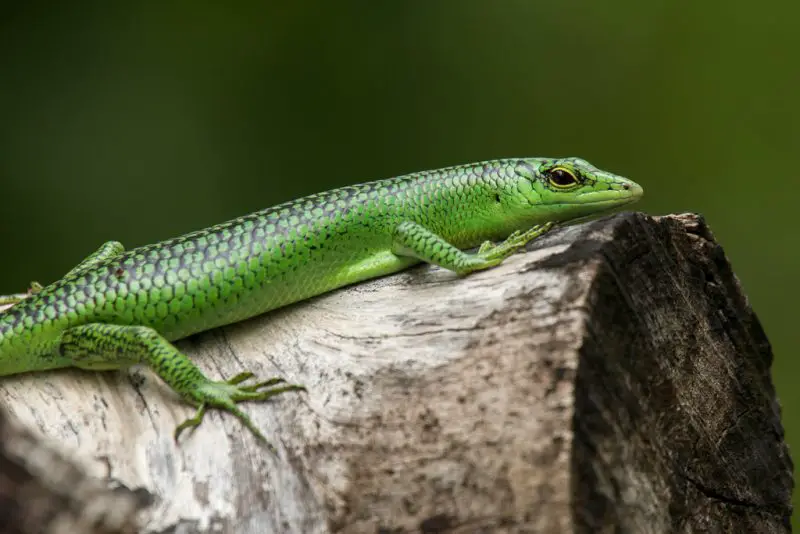
The Green Tree Skink (Lamprolepis smaragdina), sometimes called the Emerald Tree Skink, is one of the most strikingly colored lizards occasionally seen in southern Texas. Native to Southeast Asia and the Pacific Islands, it has been accidentally introduced to several tropical and subtropical regions through the plant and pet trade. This species is instantly recognizable by its smooth, glossy, emerald-green body and slender, streamlined form. Adults typically measure between 8 and 10 inches in total length, with a long tail and small, agile limbs designed for climbing.
In Texas, Green Tree Skinks have been reported mainly around coastal or urban areas where the climate is warm and humid year-round, closely resembling their native tropical habitats. They are arboreal creatures that spend most of their time in trees, shrubs, or even gardens with dense vegetation. Their green coloration provides excellent camouflage among leaves, helping them avoid predators while they hunt for insects and small arthropods. They are also known to bask in the sun on tree trunks or rooftops, showing off their vivid sheen.
Behaviorally, Green Tree Skinks are fast, curious, and often bold for a lizard of their size. They are diurnal and feed primarily on small insects, spiders, and occasionally soft fruits. Their large, alert eyes and quick movements make them highly efficient hunters. When threatened, they rely on speed and agility, darting into foliage or using their long tails for balance as they leap between branches. They rarely bite and are considered harmless to humans.
Reproduction occurs in warm months, with females laying several small clutches of eggs each year in moist soil or leaf litter near trees. The young hatch after several weeks, emerging as miniature versions of the adults, already displaying the same brilliant green scales. While still rare and not officially established as a breeding species in Texas, occasional sightings suggest that small populations of the Green Tree Skink may be adapting to the state’s southern coastal habitats, adding another touch of tropical green to Texas’s reptile diversity.
Western Green Lacerta (Lacerta bilineata)
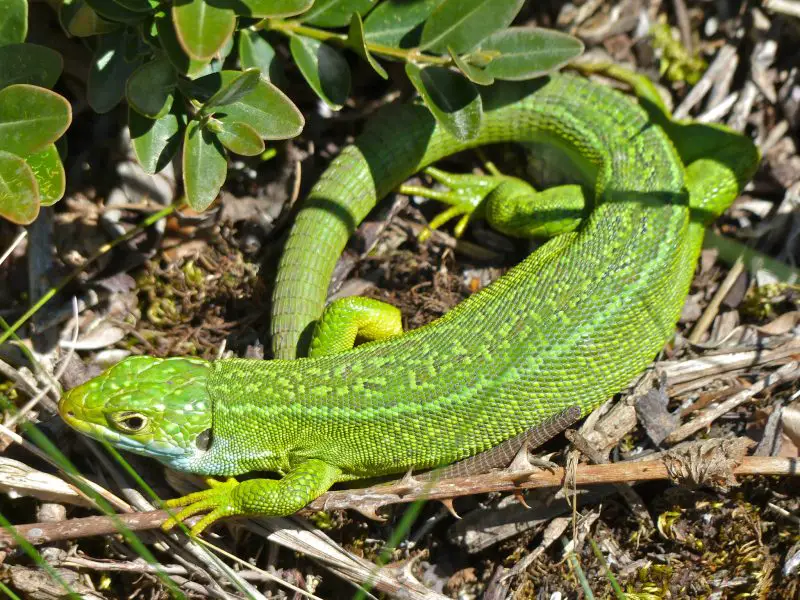
The Western Green Lacerta (Lacerta bilineata), also known as the European Green Lizard, is one of the most visually stunning lizard species occasionally encountered in Texas through accidental introduction or the pet trade. Native to western and southern Europe, this reptile is famous for its brilliant green coloration, long tail, and sleek, powerful build. Adults can grow between 12 and 16 inches long, making it one of the largest and most striking “green lizards” known to adapt temporarily to Texas’s warm environment. Its body is bright grass-green, often sprinkled with tiny black dots, while adult males display vibrant turquoise-blue throats during the breeding season.
In Texas, sightings of the Western Green Lacerta are extremely limited and generally linked to escaped or released pets, particularly in urban or suburban areas with dense vegetation and mild winters. They prefer sunny environments with abundant ground cover — such as gardens, rock walls, and grassy slopes — that mimic their natural European habitat. When conditions are suitable, they can survive outdoors for extended periods, particularly in southern and coastal regions where temperatures rarely drop below freezing.
This species is diurnal and highly active, spending much of the day basking or hunting for food among tall grass or stone walls. Their diet consists mainly of insects, spiders, and other small invertebrates, but larger individuals may also consume smaller lizards or baby rodents. They are fast runners and excellent climbers, using their strong limbs and long tails to move swiftly through vegetation. When threatened, they prefer to flee into cover but can deliver a sharp bite if cornered.
During the breeding season, males become brightly colored and territorial, engaging in short chases or displays to attract females. Females lay several clutches of eggs each year in loose soil or sand, and the young hatch after six to eight weeks. Although not a native species, the Western Green Lacerta occasionally makes its presence known in Texas’s reptile community, impressing observers with its vivid green color and bold, energetic behavior. If small populations were ever to establish, they would add another fascinating splash of European emerald to the state’s reptilian diversity.
Texas Spiny Lizard (Sceloporus olivaceus)
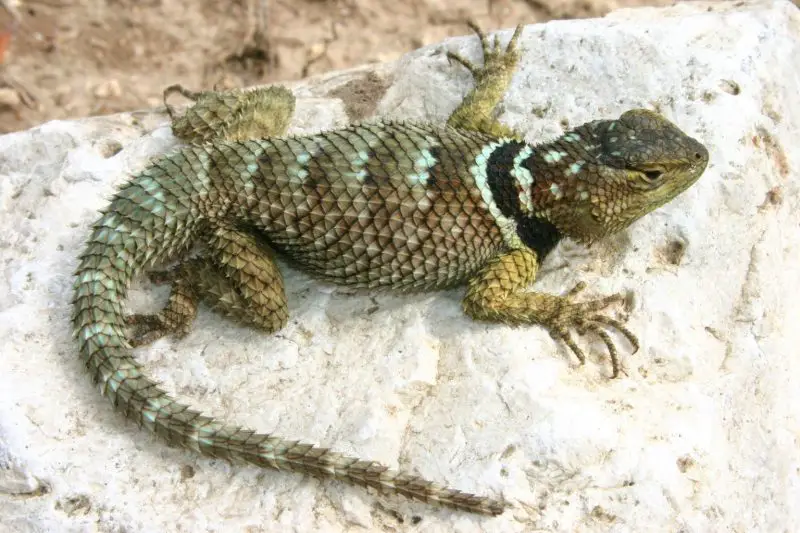
The Texas Spiny Lizard is a sturdy, medium-to-large reptile known for its rough, keeled scales and subtle olive-green to gray coloration. Adults typically measure between 7 and 11 inches in total length, with males often larger and more colorful. During the breeding season, males may develop bluish-green patches along the sides of the body and bright turquoise on the belly. These color shifts contrast beautifully against the bark-like patterns that camouflage them against tree trunks.
This species is highly arboreal and prefers to live in trees, fences, and wooden structures. Found throughout central, southern, and western Texas, the Texas Spiny Lizard thrives in semi-arid woodlands, rocky hills, and suburban gardens with plenty of tree cover. They are masters of camouflage, often remaining motionless against bark until danger passes. When startled, they sprint rapidly up trees, vanishing into foliage.
Behaviorally, Texas Spiny Lizards are diurnal and bask frequently in the morning sun. Males establish small territories and perform head-bobbing and push-up displays similar to anoles. They feed mainly on insects such as beetles, grasshoppers, and caterpillars. Their diet and arboreal habits make them valuable for controlling pest populations in rural and residential settings.
Breeding begins in spring, and females may lay several clutches of eggs through late summer. Each clutch contains up to 20 eggs deposited in sandy soil. Hatchlings emerge after about two months and grow quickly during warm weather. Because of their adaptability and tolerance for human presence, Texas Spiny Lizards are commonly seen basking on garden fences and wooden decks across much of Texas.
Five-Lined Skink (Plestiodon fasciatus)
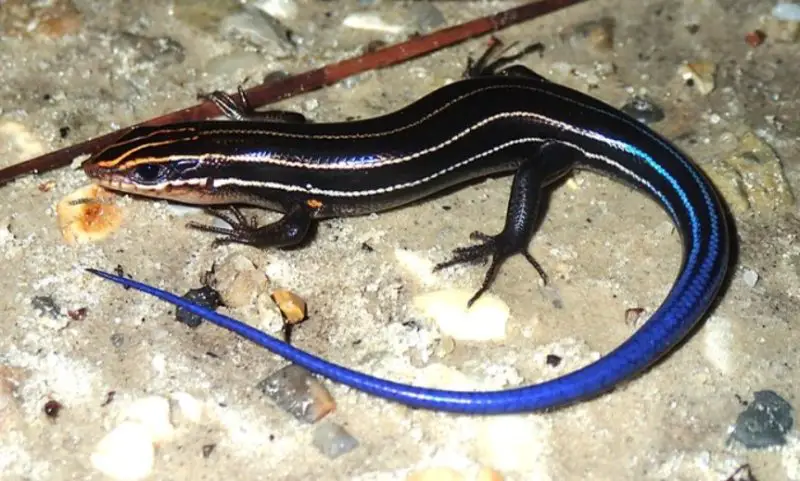
The Five-Lined Skink is a sleek and agile reptile found throughout eastern and central Texas. Juveniles are easily identified by their vivid black bodies marked with five pale stripes and a striking, electric-blue tail. As they mature, their coloration fades into olive-green or brownish tones, and adult males often develop reddish or orange hues around the head during breeding season. Adults usually grow between 5 and 8 inches long, including the tail.
This skink prefers moist habitats such as wooded areas, fallen logs, and leaf litter near creeks or ponds. In Texas, it thrives in the humid regions of the east, where shade and ground cover provide safety and foraging opportunities. It spends much of its time hiding beneath debris or within rotting wood, emerging to bask or hunt for prey when the temperature is right.
Five-Lined Skinks are diurnal and quick-moving. They feed primarily on insects, spiders, and small invertebrates, which they catch with sudden lunges and fast reflexes. When threatened, they can shed their tails — a defense mechanism called autotomy — to distract predators and escape. The tail eventually regenerates, though it rarely regains its original color or length.
Breeding occurs in spring and early summer, with females laying eggs in damp soil or under decaying logs. They display unusual maternal care for reptiles, guarding their eggs until hatching. Hatchlings emerge after 4–6 weeks, already exhibiting the brilliant blue tails characteristic of the species. The Five-Lined Skink’s adaptability and secretive behavior make it a fascinating but elusive greenish lizard in Texas’s forests.
Emerald Swift (Sceloporus malachiticus)
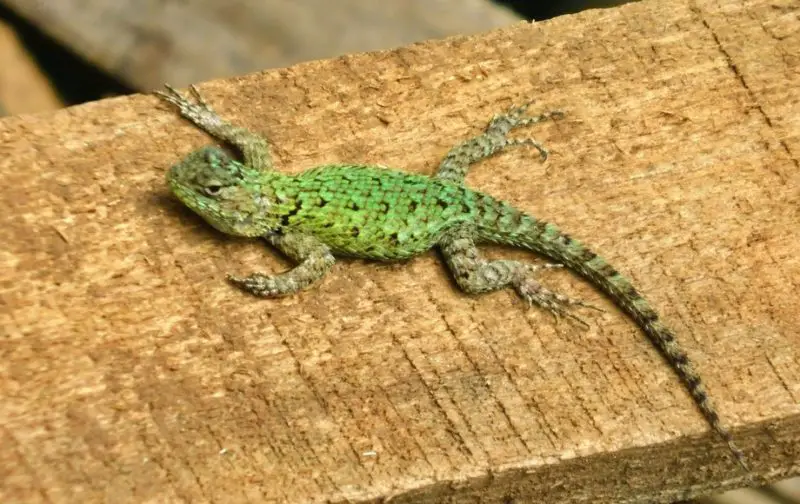
The Emerald Swift (Sceloporus malachiticus), also known as the Green Spiny Lizard, is one of the most breathtakingly colorful reptiles occasionally found in Texas through the exotic pet trade. Native to the cool, forested mountains of Central America — from southern Mexico to Panama — this species stands out for its brilliant emerald-green or turquoise-blue scales. Adult males are especially vibrant, often displaying an iridescent green body with deep blue patches on the sides and throat, while females are usually duller with olive tones. Adults typically measure between 6 and 8 inches in total length, with rough, keeled scales that give them a spiny appearance.
In Texas, the Emerald Swift is not a native species but has occasionally been observed in warm suburban or greenhouse environments after accidental escapes from captivity. These lizards prefer humid, moderately warm habitats with abundant vegetation and hiding places. In their natural range, they live in forest edges, rocky slopes, and tree trunks at mid to high elevations, but in Texas, they are most likely to survive temporarily in sheltered gardens or near structures that retain warmth and moisture.
Behaviorally, Emerald Swifts are diurnal and highly active, often basking in the sun on rocks or logs before darting quickly into cover. They are insectivorous, feeding mainly on flies, beetles, and small arthropods. Their sharp claws and muscular limbs make them excellent climbers, while their bright coloration acts both as camouflage among foliage and as a display during territorial or courtship interactions. Males are territorial and perform head-bobs or body push-ups to warn rivals and attract females.
Reproduction occurs in spring and summer, and unlike many other lizards, Emerald Swifts give birth to live young rather than laying eggs. Females produce several offspring that emerge fully formed and capable of independent movement. Though rare outside captivity, the occasional sighting of an Emerald Swift in Texas adds a dazzling splash of tropical green to the state’s reptile scene — a fleeting but unforgettable reminder of how vibrant nature can be when the colors of the tropics meet the Texas sun.
FAQs about Green Lizards in Texas
What is the most common green lizard in Texas?
The Green Anole (Anolis carolinensis) is the most common and widespread green lizard in Texas. It’s the only native species with a bright emerald-green body that can change to brown depending on temperature and mood. Green Anoles are often seen in trees, gardens, and fences throughout eastern and southern Texas.
Are there any large green lizards in Texas?
Yes. The Knight Anole (Anolis equestris), though not native, is a large bright-green species occasionally found in southern Texas. It can reach up to 13 inches long and has a pink dewlap under its chin. However, sightings are rare and usually limited to warm urban areas or near greenhouses.
Do Green Anoles share their habitat with other green lizards in Texas?
Yes. Green Anoles often share their environment with several other green species, such as the Texas Spiny Lizard or the Italian Wall Lizard, especially in warm and vegetated areas. While these species may overlap in range, they usually occupy different spaces — Green Anoles prefer trees and fences, while others stay closer to rocks or open ground. This natural separation allows them to coexist without strong competition.
Where can I find green lizards in Texas?
Green lizards are most abundant in eastern and coastal Texas, where the humidity and vegetation provide suitable shelter. You can find them around wooded areas, gardens, parks, and suburban neighborhoods. During warm months, they are active during the day and can be spotted basking or hunting insects.
Do green lizards in Texas make good pets?
The Green Anole is sometimes kept as a pet because of its manageable size and beautiful color. However, it requires proper humidity, heat, and UV lighting to stay healthy. Wild anoles should not be captured, as they play an important ecological role in controlling insect populations and supporting the local ecosystem.




